Use this rounding calculator for decimals to round up and down to tenth, hundredth, whole numbers, tens, hundreds and more.
Rounding numbers is very important when you want to record long numbers and when you want to preserve significant figures in calculations. The truth is that you keep using rounding numbers all the time. From when you need to divide the bill when you’re eating at a restaurant, when you are calculating a tip or when you are still thinking about how much money you need to take with you when you go to the grocery store.
What Are Round Numbers?
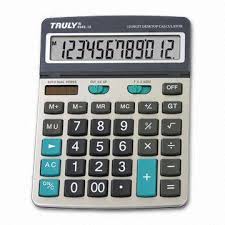
Simply put, a rounded number has around the same value as the number that you started with. However, it is less exact.
So, this means that when you are rounding numbers you will be adjusting the digits either up or down to turn your calculations easier. Notice that you will also get an approximate result and not a precise one.
Why Do We Round Numbers?
While you already know what round numbers are, we believe that it is important that you understand how useful they are.
The reality is that numbers have always been very important to humans since the earliest civilizations. However, as you can imagine, some have had more importance than others.
When you are thinking about numbers, it is impossible not to think about those that we know represent fact. For example, you know that there are 60 minutes in an hour, 12 eggs in a carton, and 360 degrees in a circle. But why is an hour 60 minutes and not 100? Why does an egg carton come with a dozen eggs and not with 10, for example? The truth is that there is a reason behind all these numbers that we keep using every day.
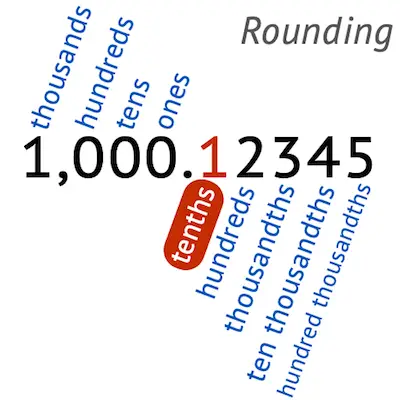
The truth is that human beings prefer to use round numbers. After all, they are not only easy to process, easy to make sense of, as they are also simpler and easy to understand. Besides, it is important to notice the influence that round numbers have on your life in other ways as well.
If you think about Major League players, it is 4 times more likely that they end a season with a .300 batting average than with a .299 batting average. And if you consider SAT takers, for example, it is also more likely to have takers retaking the test if they fall short of a round number. Besides, you also tend to consider a round number when you set specific goals for yourself. Just think about when you want to lose a specific amount of weight or when you want to run a marathon at a certain pace.
We can then state that our world is dominated by the base-10 system or the decimal system. After all, you tend to use it to talk about your age, negotiate your salary or even when you are estimating expenses. You talk about being in your 30s, and your 40s, and your 50s. You don’t talk about being in your 37s, for example.
However, this isn’t the only system that we use. About 5,000 years ago, the Sumerians developed a sexagesimal system – a base-60 system. And the truth is that we still use this system or many things in our lives. Just think about the 360 degrees, the 60 minutes or the 60 seconds.
Besides, there is also the base-12 system that most experts believe that is older than the base-60 system we just mentioned. You just need to think about the 12 hours, 12 inches or a doze.
Based on all this, we can definitely state that:
- Rounded numbers are only approximate numbers.
- Rounding makes numbers easier to work with in our heads.
- You can use rounding when you want to get an answer fast.
- When you are using rounded numbers, you won’t ever get an exact answer.
How To Round Numbers
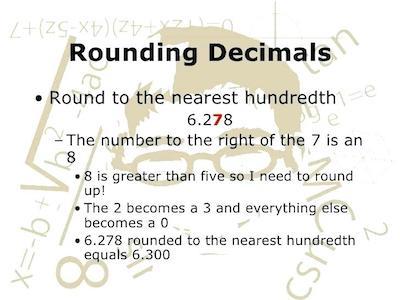
When you decide to round a number, you will be working with fewer digits in most cases. So, while rounding numbers aren’t as precise than non-rounded numbers, we have already seen that they can be very helpful in a wide range of situations on a daily basis.
So, we decided to show you three different methods that you can use when you need to round off numbers.
Method #1: Round Off Decimals:
When you are looking to round off decimals, you will need to first determine the place value to which the number is to be rounded. This can be determined based on the context and the sets of numbers that you’re using or, if you are still in school, this can be determined by your teacher. For example, when you are trying to round money, it is normal that you round it to the nearest hundredth or the nearest cent. In case you are rounding a weight, for example, you will want to round the number to the nearest pound.
Let’s say that you are working with the number 10.7659 and that you decided to round it to the thousandth digit. In this case, you will need to look at the digit in the thousandths place, the number 5, which is the third digit to the right of the decimal point.
Now that you know that you want to round this number to the thousandth, you will need to look at the number that is to its right. In addition, you will need to check if this new number is either 4 or less than 4 or, on the other hand, if it is greater than or equal to 5. In our case, you have the 9 in this place. And since 9 is greater than 5, you will need to round the 5 digit up. So, it will become a 6. When you do this, all the numbers that are on the right of this number will disappear no matter if you are talking about 1 number, 5 numbers or 10. So, at this moment, you have a new rounded number: 10.766.
Let’s say that you were now working with a different number. In this case, that number would be 10.7653. Let’s also imagine that you want to still round it to the thousandth. Now, the number that is in the thousands place is again the number 5. So, as we already saw above, you will need to look at the number that is at its right. In this case, it is number 3. Since this number is lesser than 4, then you will need to round the 5 down and it will become a 4. So, in this case, you will get the 10.764 as your rounded number.
Method #2: Rounding Off Whole Numbers:

Let’s now take a look at how you can easily round off whole numbers.
Let’s say that you want to round off a number to the nearest tens digit. In order to do this, you will need to look at the number that is at the right of the tens digit. In case you don’t know, the tens digit is the digit that is second from last in a number before the ones digit. Imagine that you are looking at number 52. In this case, you need to look at number 2.
Then, you will need to go through again the number to determine if this number is less than 5 or if it is equal or greater to 5. In case the number is less than 5, you will maintain the original number. In case it is equal or greater than 5, then you will need to go up one digit.
Here are some examples:
- 234 – the rounded number to the nearest tens is 230
- 98 – the rounded number to the nearest tens is 100
- 13 – the rounded number to the nearest tens is 10
- 1,777 – the rounded number to the nearest tens is 1,780
Let’s now imagine that you want to round off a number to the nearest hundreds digit. Well, in this case, instead of looking at the tens digit, you will need to look at the hundreds digit. This is always the third digit from last in a number. For example, in the number 6473, the 4 is the hundreds digit. Again, you will then need to look at the number at its right to determine if you will maintain the original digit or if it will need to go down for a digit. The goal is to make a number after it even 00s.
Here are som examples:
- 350 – the rounded number to the nearest hundreds is 400
- 99,954 – the rounded number to the nearest hundreds is 100,000
- 16,857 – the rounded number to the nearest hundreds is 16,900
- 5,445 – the rounded number to the nearest hundreds is 5,400
The final example we want to show you when we are talking about rounding off whole numbers is when you need to round off a number to the nearest thousands digit. Again, the same rules apply. The only difference is that since you are now looking to round the number off to the nearest thousandths, you will need to look at the thousandth digit. This is the fourth digit from the end of the number. Let’s say that you have the number 45,960. In this case, you would need to look at the 5 digit.
Here are some examples:
- 478,456 – the rounded number to the nearest thousands is 478,000
- 1,234 – the rounded number to the nearest hundreds is 1,000
- 12,601 – the rounded number to the nearest hundreds is 13,000
- 12,499 – the rounded number to the nearest hundreds is 12,000
Method #3: Rounding Numbers to Significant Digits
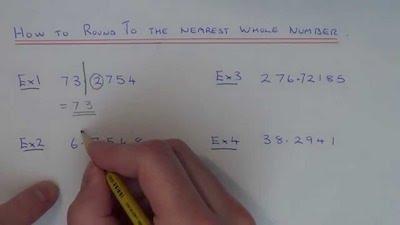
Before we explain to you how this method works, we believe that it is important to clarify, in the first place, what a significant digit is.
Simply put, you can think of a significant digit as an important or interesting digit that is able to give you useful information about a number. But what does this mean? Well, this means that all the zeroes that are at the right of the whole number or at the left of decimals can simply be discounted since they are placeholders.
When you are trying to determine the number of significant digits that a number has, you will need to count them from the left to the right. Here are some quick examples so that you can fully understand this definition:
- 3782 has 4 significant digits
- 0.04637 has 4 significant digits
- 195.87 has 5 significant digits
So, now that you already know what significant digits are, then it is time to learn how you can round numbers to significant digits.
When you are trying to round a number to an amount of significant digits, then you need to consider the problem you are working on. The truth is that if you are rounding a number to 2 significant digits, you will need to identify the second significant digit of the number. After that, you will need to use the number that is on its right to see if you need to round it up or down.
Let’s take a look at some examples:
Let’s say that you have the number 1.239 and that you want to round it to 3 significant digits. In this case, the third digit is the 3. So, you need to look at the one that is on its right to see if you’re going to round the 3 up or down. Since it is a 9, you the 3 will become 4 leaving you with the new rounded number 1.24.
Let’s now say that you have the decimal 0.0165 and you want to round it to 2 significant digits. As you can see, this number only has 3 significant digits and the second one is the 6 digit. So, if you look at the number on its right – number 5, you can then state that you’ll need to round it up. So, you will get the rounded number 0.017.
Imagine that you want to round to one significant digit the number 134.9. As you can see, you will need to look at the 1 and then at the 3, which is the number on its right. Since 3 is fewer than 5, then you know that you will need to round down. So, you will end up with a new rounded number of 100.
How To Round Numbers – Using Our Rounding Calculator
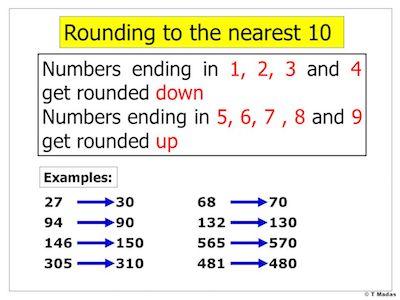
When you are learning to round numbers and you want to confirm your results or in case you simply need a quick answer, then you need to check out our rounding calculator which is located at the top of this page.
One of the best things about using our rounding calculator is that it is not only free as it is very easy to work with. Besides, you are about to discover that with our rounding calculator, you can round all the numbers you want and even use different rounding methods. But let’s take one step at a time.
If you take a closer look at our rounding calculator, you can easily see that you have three distinct spaces: the first one is where you should add your number no matter if it is a whole number or a decimal. Our rounding calculator will help you with both. The second one refers to the way you want to round your number. Here, you can choose many different options:
- Round to the nearest tenth
- Round to the nearest hundredth
- Round to the nearest thousandth
- Round to the nearest one
- Round to the nearest ten
- Round to the nearest hundred
- Round to the nearest thousand
- Round to the nearest 10,000
- Round to the nearest 100,000
- Round to the nearest million
As you can see, you have all the options that you need.
In the third place, you will need to select the rounding mode that you want our calculator to use. You can choose between 9 different rounding modes or methods. We will be telling you a bit more about each one later.
For now, you just need to understand that as soon as you add the number that you want to round and then choose to how you want to round it and the rounding mode that you want to use, you just need to click on the Calculate button and our rounding calculator will immediately tell you the result.
Rounding Numbers By Hand With Practical Examples
As we have seen so far, there are many different ways that you can use to round your numbers. While you can simply use our free calculator to do it, we believe that it is also important that you know how to do this on your own.
So, let’s check the different rounded numbers that you can get as well as you can easily turn a number into a rounded number without any problems.
#1: Round To The Nearest Tenth Calculator
As we already showed you, you can easily use our round to the nearest tenth calculator to perform this calculation. However, we also want to ensure that you can do it on your own.
The truth is that there are many different situations when you will need round decimals to the nearest tenth to make the number easier to work with. Besides, when you understand how this works for decimals, you won’t have any problems rounding whole numbers as well.
So, let’s say that that you have the number 7.86 and you want to round it to the nearest tenth.
The first thing you need to do is to look at the number than comes in the tenth place. In case you don’t know or you won’t remember, this is the number that is immediately to the right of the decimal point. So, in this case, it’s the number 8. Now, you will need to take a look at the digit that is at the right of this one to know if you will need to round the tenth number up or down.
In case you don’t recall, when you have a number that is equal or great than 5, you round up and when you have a number that is less than 5, you will round down.
Getting back at our example, the number that is on the right of the tenth number is the 6. So, you will need to round up and you will end up with the rounded number 7.9.
Let’s take a look at a different example. Let’s say that you are now trying to round the number 247.137 to the nearest tenth. So, in this case, the number that is in the tenth place is the 1. Remember that this is the number that immediately follows the decimal point. So, you will then need to look at the right side of this number and you see the number 3.
As we already told, you, when this number is inferior to 5, then you will need to round down. This means that you will end up with a new rounded number: 247.1.
One of the things that you need to keep in mind when you ar rounding numbers to the nearest tenth is that there are special cases. One of them is when you have to round down to a zero in the tenths place.
Here’s an example. Let’s say that you need to round the number 4.03 to the nearest tenth. If you check, the tenth number is the 0. So, as you look at its right, you see that the number is 3. This means that you would need to round down the number. However, since you have a 0 in the tenth place, you will simply maintain it.
This means that you will end up with the new rounded number: 4.0. While you could simply right 4, the truth is that this way you are clearly showing you that you know how to round numbers even when you don’t use a round to the nearest tenth calculator.
#2: Round To The Nearest Hundredth Calculator
When you are trying to round a number to the nearest hundredth calculator, then you need to know that the nearest hundredth is the second digit after the decimal point.
Let’s take a look at some examples.
Imagine that you want to round the number 124.586 to the nearest hundredth. So, as we just told you, you will need to look at the second digit after the decimal point. In this case, you will be looking at the number 8. Now, and following the same procedure that we described previously, you will need to look at the right side of this number. In this case, it’s the number 6. Since 6 is greater than 5, then you will need to round up. So, you will get a new rounded number: 124.59.
Here’s a new example. Just suppose that you need to round the number 3.141 to the nearest hundredth. So, again, you will need to look at the second digit after the decimal point. In this case, you’ll be looking at the number 4. Now, the number that immediately follows it (to the right) is number 1. Since 1 is less than 5, then you will need to round down. So, you will get a new rounded number: 3.14.
In case you need, just use our round to the nearest hundredth calculator to confirm your results.
#3: Round To The Nearest Thousandth Calculator:
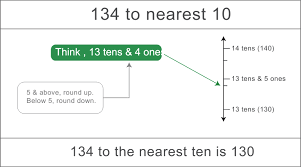
Before we proceed with the examples, we want to be sure that you understand what number you will be rounding. So, in case you don’t remember or if you simply don’t know, the nearest thousandth is the third digit after the decimal point.
So, let’s check two different examples so that you can fully understand the rounding mechanism.
Let’s imagine that you want to round the number 3.8792 to the nearest thousandth. As we already mentioned, you will need to look at the third number to the right of the decimal point. So, in this case, you will need to look at number 9 since this will be the number that you will be rounding (up or down). So, to determine how you’re going to round it, either up or down, you will need to look at the number at the right of this number. In this case, this number is 2. Since 2 is inferior to 5, then you will need to round down. This means that you will end up with a new round number: 3.879.
Her’s another example. Let’s now imagine that you want to round to the nearest thousandth the number 3.1416. In this case, the number that you will need to round is the third one after the decimal point which is 1. Then, you will look at the number that it follows to the right – 6. Since 6 is greater than 5 then you will need to round up. This means that you will end up with a new rounded number: 3.142.
In case you need or if you want to check your results, just use our round to the nearest thousandth calculator.
#4: Round To The Nearest Whole Number Calculator:
When you are looking to round a whole number, the process will be even simpler. After all, you just need to check the location of the number that corresponds to the desired rounding in the number to be rounded.
Here’s a quick rounding numbers example. Let’s say that you want to round to the hundred the number 53643.
When you want to round a number to the hundreds, you will need to look at the third digit, counting from the left. So, as you can easily see, we are talking about number 6. So, to determine if you will need to round the number 6 either up or down, you will need to take a look at the number that is on its right. This is number 4. Since 4 is inferior to 5, then you will need to round down.
Remember that when you are rounding numbers to the hundreds, you will end up with 00 at the end of the number. So, in this case, your new rounded number is 53600.
#5: Rounding Numbers To The Nearest Ten
So, what do you need to do when you are looking to round numbers to the nearest ten?
Well, it’s pretty simple as you are about to see. Let’s confirm it with an example since we believe this is the best way that we have to show you how the process goes.
Let’s say that you want to round to the nearest ten the number 323.5.
In this case, you will need to identify the digit in the tens place. As you can see, the number is 2. Then, to determine if you will need to round this number 2 either up or down, you will need to check the number that is at it right. In this case, it’s number 3. Since 3 is inferior to 5, then you will maintain the 2 in position.
Remember that when you round a number to the nearest ten, you will always end up with a number that ends in 0. Getting back at our example, you will get a new rounded number: 320.
Her’s another simple example. Imagine that you want to round to the nearest ten the number 499. Again, you will need to look at the tens digit. In this case, it’s number 9 (the first one in 499). So, to know if you will need to round up or down the 9, you will need to look at the number on its right. In this case, this is the number 9. So, you will need to round it up and you will end up with a new rounded number: 500.
Just use our rounding numbers to the nearest ten calculator to confirm your results.
#6: Round To The Nearest Hundred Calculator
Just like we already showed you above when we were talking about rounding whole numbers, when you are rounding numbers to the nearest hundred, you will need to look at the hundreds digit. Besides, you need to know that your numbers will always end with 00.
Here’s a quick example. Let’s say that you want to round to the nearest hundred the number 431. If you take a look at this number, you can easily see that the hundreds number is 3. So, by looking at its right to know if you’ll need to round up or down, you see the number 1. Since 1 is inferior to 5, then you will round down. This means that you will end up with a new rounded number: 400.
But let’s see another example. Imagine that you want to round to the hundreds the number 958. If you check, the hundreds number is 5. So, by looking at its right, you can see that you have the number 8. Considering that 8 is greater than 5, then you will need to round up. This means that you will end up with a new rounded number: 1000.
In case you prefer, you can always use our round to the nearest hundred calculator.
The Different Rounding Modes Or Methods
As we told you when we were explaining to you how you could use our rounding numbers calculator, there are different rounding modes or methods that you can use when you are rounding numbers.
If you remember, and up until now, we have always been using the same rounding numbers mode – the default one. However, there are many more and you should understand each one of them.
#1: Round To The Nearest (Default) Mode:
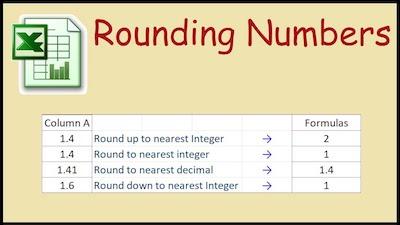
This is simply the mod or method that we have been using so far. There are mainly two rules when you are using this method. When you have a number that is equal or greater than five, then you will ned to round up the number. On the other hand, when you have a number that is less than five, then you will need to round it down.
#2: Round Half Up Mode:
While you may have never heard or use this method before, the truth is that the round half up mode is very popular and is actually very used.
When you are rounding numbers using this method, you just need to keep in mind that you will be rounding values that exist halfway between the selected rounding precision up.
Let’s say that you want to round the following numbers to ones place. In this case, you would get:
- 5.50 – when rounded to the ones place, you will get 6.
- 5.49 – when rounded to the ones place, you will get 5.
- 5.51 – when rounded to the ones place, you will get 6.
In case you’re not using a rounding decimals calculator or a rounding numbers calculator, then you ned to pay extra attention if you need to round a negative number. Besides the fact that you will ned to maintain the minus sign in the end of the process, you need to know that the definition may be a bit ambiguous when you are dealing with negative numbers. Let’s say that you want to round to the ones place again the following numbers:
- -5.50 – when rounded to the ones place, you will get -5.
- -5.49 – when rounded to the ones place, you will get -5.
- -5.51 – when rounded to the ones place, you will get -6.
#3: Round Half Down Mode:
As you can easily imagine, the Round Half Down Mode is exactly the opposite of the Round Half Up Mode. The difference is that, rather than up, you will be rounding values that are midway between the selected rounding precision down. Here are some examples when you need to round to the ones place:
- 5.50 – when rounded to the ones place, you will get 5.
- 5.49 – when rounded to the ones place, you will get 5.
- 5.51 – when rounded to the ones place, you will get 6.
Again here, the definition is a bit ambiguous when you are dealing with negative numbers. So, to ensure that you completely understand the process, here are some examples of numbers that you want to round ones place:
- -5.50 – when rounded to the ones place, you will get -6.
- -5.49 – when rounded to the ones place, you will get -5.
- -5.51 – when rounded to the ones place, you will get -6.
#4: Round Up (Ceiling) Mode:
When you are asked to use the round up – ceiling mode, then you need to know that you may also be told to “take the ceiling”. This mode implies that you will need to round up a number towards the nearest whole number.
Let’s imagine that you are rounding to the ones place and that any value that is not a whole number will be rounded up to the next highest integer. This is the case when you want to convert the number 5.01. By following this mode, you will get the new round number: 6.
What about if the number you want to round is negative?
In the matter of negative numbers, rounding up means rounding a non-integer (not a whole number) negative number to its following closest, more positive integer. For instance, -5.01 will be -5, -5.50 will be -5, and -5.99 will be -5.
#5: Round Down (Floor) Mode:
Also referred to as the “taking the floor”, this mode is very similar to the previous one. The difference is that instead of rounding up, you will be rounding down.
#6: Round Half To Even Mode:
Since it does not have any biases based upon positive or negative numbers or rounding towards or away from zero, rounding half to even can be utilized as a tie-breaking rule.
For this technique, half values are rounded to the nearest even whole number. For instance: 5.5 will be 6; 6.5 will be 6; -7.5 will be -8; -8.5 will be 8.
#7: Round Half To Odd Mode:
Rounding half to even (above) is similar to rounding half to odd and can be used as a tie-breaking rule. For this technique, half values are rounded to the nearest odd whole number. For instance: 5.5 will be 5; 6.5 will be 7; -7.5 will be -7; -8.5 will be -9.
Discover 5 everyday use of rounding numbers.
#8: Round Half Away From Zero Mode:
As a tie-breaking rule, rounding half away from zero can be utilized and it means precisely as those words describe: rounding half values away from zero. It has no biases regarding negative or positive numbers, but it does have a bias away from zero. Different way to think of the rounding technique is to round a half value towards the following whole number closer to positive or negative infinity based upon whether the value is positive or negative. For instance: 5.5 will be 6; -5.5 will be -6.
Learn more about rounding for accounting accuracy.
#9: Round Half Towards Zero Mode:
Rounding half away from zero is similar to rounding half towards zero, except that rounding half away from zero rounds in the contrary direction. It has no biases towards negative or positive numbers, but it does have a bias towards zero. So, half values will be rounded towards the following whole number that is much closer to zero than it is to positive or negative infinity. For instance: 5.5 will be 5; -5.5 will be -5.